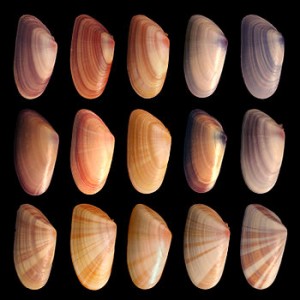| English: Various coquina shells. Individuals in the mollusk species Donax variabilis show diverse coloration and patterning in their phenotypes. (Photo credit: Wikipedia) |
Few of my friends posted on Dermatologists Sans Borders about the frustrations of having a unique and rare name. How it is misspelt and how people invent new pronunciations. But there is an upside to this as well. If you discover a “unique” variant of a disease, you can give it your name! Bell’s palsy, disease and sign are already taken 🙁
Find a unique pattern of vitiligo lesions or LP sparing one side of the wrist and give it your name. You also have the option of naming procedures as well. Hold the scalpel at 47 degrees and call it xyz technique. (Is there a Bell’s procedure? If not, I should register it for future use) Our journals play a major role in encouraging these derma-neologisms. Our dermatology teaching curriculum is also to blame. I am sure the topper in any dermatology postgraduate department will be the student who knows the maximum number of names.
What are the consequences of these seemingly innocuous desire for some to immortalize their names through dermatology literature? (Maybe it is there in other specialities as well). It makes terminology systems too complex. New names may gradually percolate into billing and disease codes making them unnecessarily bloated. New dermatology residents have one more name to learn, one more question to answer during exams, one more tricky question to add for the dermatology quiz master. Gradually regional variations creep into disease descriptions and understanding leading to confusion during conferences and seminars. Infact very few names actually add value to domain knowledge and patient care.
The DermLex(TM) project from Rochester, now transferred to and hosted by AAD is an attempt at reversing this trend. The project aims at organizing the dermatology terms under a formal hierarchy for better domain understanding, not just by humans but by machines too. In my opinion machine readable ontologies need more formal representation as I tried in ONTODerm and then extended in DermBASE (yeap. 2 more names).
What motivated me to write this post though, is not the DermLex, but a little known project with no dermatology representation at present. As vast amounts of Electronic Medical Records data become available for secondary data analysis, we now have the opportunity to identify how diseases are classified as phenotypes in real life as opposed to named disease archetypes with subtle differences, sleeping in the pages of medical textbooks.
Identifying such real world phenotypes will help us in categorizing diseases in a practical way. It will also help clinical research by clearly identifying cases and controls. The home page of the initiative (PheKB) is available here. I also came across a similar methodology in Dr Nigam Shah’s work here.

- Machine learning-based BOTOX API - April 11, 2023
- Skinmesh: Machine learning for facial analysis - November 10, 2020
- Free Dermatology EMR for Machine Learning and Artificial Intelligence - January 2, 2020






Leave a Reply